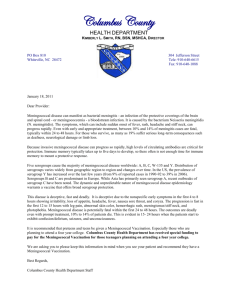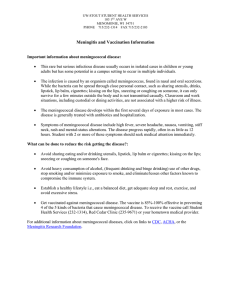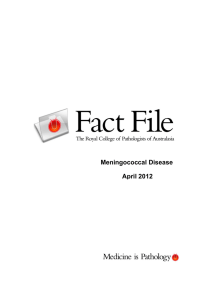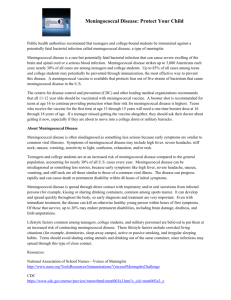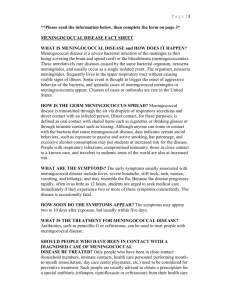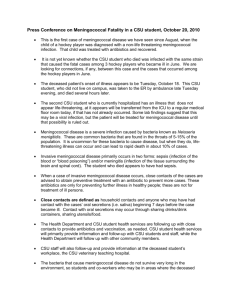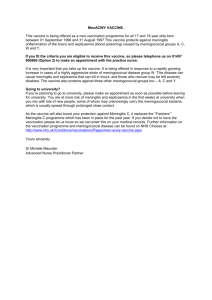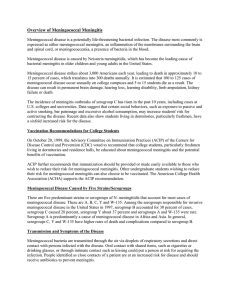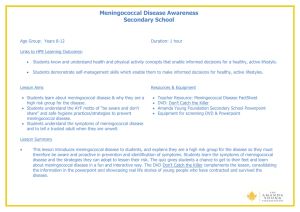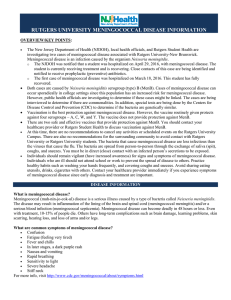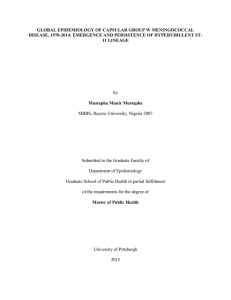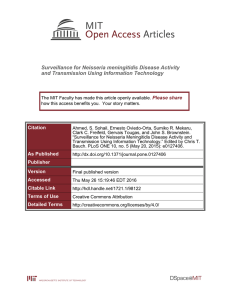MENINGOCOCCAL DISEASE
advertisement
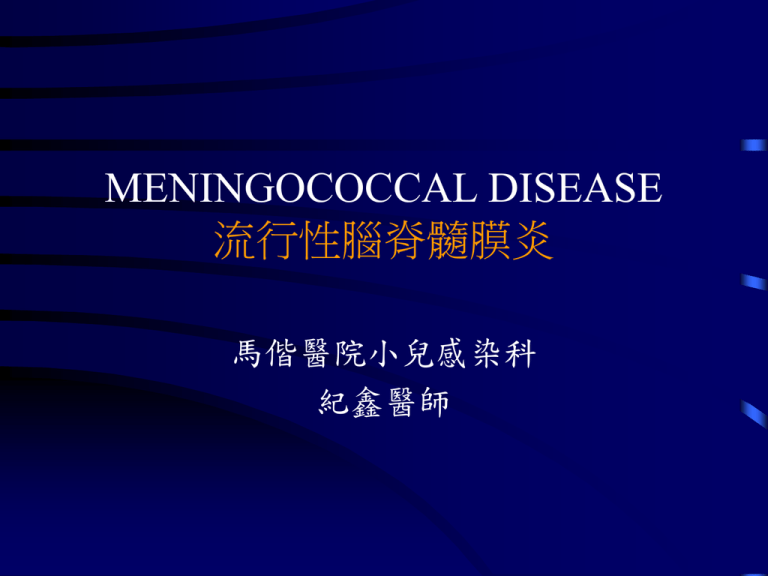
MENINGOCOCCAL DISEASE 流行性腦脊髓膜炎 馬偕醫院小兒感染科 紀鑫醫師 The Disease Which Raged During the Spring of 1805 Gaspard Vieusseux It commences suddenly with prostration of strength, often extreme: the face is distorted, the pulse feeble. There appears a violent pain in the head, especially over the forehead; then there comes pain of the heart or vomiting of greenish material, stiffness of the spine, and in infants, convulsions. In cases which were fatal, loss of consciousness occurred. The course of the disease is very rapid, termination by death or by cure. In most of the patients who died in 24 hours or a little after, the body is covered with purple spots at the moment of death or very little time afterward. Epidemiology • In the United States, approximately 3000 sporadic cases occur each year. • Nasopharyngeal carriage rate: 3-15% • Belt across sub-Saharan Africa: 1% • In Taiwan, 81 sporadic cases occurred from 1992 to 2000 including 8 fetal cases. • In 2001, 30 sporadic cases occurred including 6 fetal cases. Microbiology Family Neisseriaceae contains five genera: • Neisseria • Kingella • Eikenella • Simonsiella • Alysiella. Genus of Neisseria • • • • • • • N. gonorrhoeae N. meningitidis N. kochii N. sicca N. lactamica N. subflava N. flavescens •N. mucosa •N. cinerea •N. polysacchreae •N. elongata •N. macacae •N. canis •N. dentrificans. N. meningitidis • gram-negative diplococcus, kidney beans, encapsulated • facultatively anaerobic, catalase (+) and oxidase (+) • autolyse when exposed to drying or sunlight • 13 serogroups currently are recognized: A, B, C, D, H, I, K, L, X, Y, Z, W135, and 29E. Chemical Structure of Group-Specific Polysaccharide Capsules of Meningococci Group Chemical Composition of Capsule A 2-Acetamido-2-deoxy-D-mannopyranosyl phosphate -2.8 N-acetylneuraminic acid -2,9 O-acetylneuraminic acid Composition not known 2-Acetamido-2-deoxy-D-glucopyranosyl phosphate 4-O--D-glucopyranosyl-N-acetylneuraminic acid Composition not known 3-deoxy-D-manno-octulosonic acid 4-O--D-galactopyranosyl-N-acetylneuraminic acid B C D X Y Z 29E W135 • Serogroups A, B, and C account for more than 90 % of meningococcal disease worldwide. • Serogroup A: periodic epidemics in developing countries, is responsible for only 3 % of in the United States. • Serogroup B: sporadic disease but occasionally is associated with outbreaks. • Serogroup C: associated with numerous outbreaks in the United States, Canada, and Europe. • Serotype Y: has been associated with meningococcal pneumonia in military recruits. • The germ is spread by direct contact with secretions from the nose and throat, such as by kissing, coughing, sneezing, and sharing of cigarettes, drinks, and food. • Prevalence : winter and spring • Incubation period: 1-10 days, most < 4 days Risk factors • • • • • • inversely to age upper respiratory pathogens smoke and passive smoke family members late complement component deficiencies alternate pathway (properdin) deficiency Clinical manifestations • • • • • • • • Serious/Invasive Disease Conjunctivitis Pharyngitis Meningococcal Pneumonia Meningococcal Pericarditis Mesenteric Adenitis and Peritonitis Infections of the Genitourinary Tract Chronic Meningococcemia Symptoms and Signs • Symptoms are usually sudden and initially are like the flu: fever, feeling generally unwell, headache, vomiting, and in some cases a stiff neck. • People with this disease are visibly sick and may be confused, excited, or drowsy. • Sometimes a reddish-purple rash that may look like bruises appears. • The rash is flat and smooth, does not itch, and may spread quickly once it starts. • In rare cases, the symptoms are followed by lowered blood pressure, shock, delirium, sudden extreme weakness, coma, and death. • Because the disease spreads quickly in the body, it is important to see a physician immediately if symptoms suggesting meningococcal disease develop. Signs and Symptoms in Serious Meningococcal Disease Clinical Feature Per Cent at Presentation Fever 71-88.8 Rash 68.4-71 Shock 38-42 Vomiting 34-67 Lethargy 30-55 Headache 34 Irritability 21-34 Poor feeding 18 Cough or rhinorrhea 18 Seizures 8-10 Laboratory findings • • • • • • Leukopenia <5000/ mm3 : 21 % Thrombocytopenia : 14 % Hyponatremia(SIADH): 7% DIC Acidosis Liver function Diagnosis • Culture: Gold standard Blood culture alone is positive about 50 % • Gram stain: Rapid diagnosis • Counterimmunoelectrophoresis and latex agglutination: Cross reaction to E. coli or bacillus • Polymerase chain reaction : newer tests Specificity : 91 % Case Definitions for Invasive Meningococcal Disease Therapy • For penicillin-susceptible meningococcemia or meningitis, iv penicillin G, 250,000 units/kg/day every 4 hours for 7 days. • Third-generation cephalosporins, ceftriaxone (100 mg/kg/day iv in two divided doses) and cefotaxime (200 mg/ kg/day iv in four divided doses • Steroid therapy is controversal Presenting Features of Meningococcal Infection Associated with Poor Prognosis • Presence of petechiae < 12 hours before admission • Presence of hypotension (systolic <70 mm Hg) • Absence of meningitis (<20 WBC/mm3) • Peripheral white blood cell count <10,000/mm3 • Erythrocyte sedimentation rate <10 mm/hour Stiehm, E. R.et al J. Pediatr 1966 Additional prophylactic • Rifampin, 10 mg/ kg/dose (maximum, 600 mg/dose) every 12 hours for 2 days • Single ceftriaxone (125 mg IM for children < 12 years of age or 250 mg IM for those > 12 years of age) Disease Risk for Contacts of Index Cases of Invasive Meningococcal Disease Chemoprophylaxis Drug Age Group Dose Rifampin <1 month 5 mg/kg q 12 hr 2 days > 1 month 10 mg/kg q 12 hr 2 days Adults 600 mg q 12 hr 2 days Ciprofloxacin Adults 500 mg Single dose Ceftriaxone <15 years 125 mg IM Single dose Adults 250 mg IM Single dose Duration Recommendations for Administration of Meningococcal Vaccine 腦膜炎雙球菌 (Neisseria meningitidis) •革蘭氏陰性球菌,成對存在。 •流行性腦脊髓膜炎,法定傳染病。 • 2-30% 正常人的鼻咽部就可能存在。 •到目前為止已經發現有十三種血清群 (serogroups) ,其中以A、B、C、W135與Y等五 種血清群最常導致疾病。 • 大多出現於冬天與春天 • 容易在開發中國家發生流行 • 菌血症: 有時只表現出伴隨發燒的上呼吸道感 染症狀,這種菌血症有時會自行痊癒,有時則 導致腦膜炎。 • 敗血症: 臨床症狀很像一般的感冒,包括發燒、 喉嚨痛、肌肉痛、頭痛與全身無力。 • 腦膜炎: 出現腦膜炎的時候,會有嚴重頭痛、 嘔吐、頸部僵硬等現象。 • 散發性血管內凝血: 導致全身出血點、敗血性 休克、腎上腺出血、腎衰竭、心臟衰竭與昏迷。 • 二歲以下兒童大約佔受感染病例的一半,但成 人也會發病,大約四分之一的病例出現於三十 歲以上成人。 • 根據美國的統計,當地嚴重感染的發生率為每 年每十萬人有1.1位病例,中國大陸與非洲的發 生率則為每年每十萬人有10-25位病例。 • 台灣地區最近十幾年並不常見這種感染,每年 的病例數只有個位數或十幾、二十幾位,但從 去年開始,病例數有稍微增加的趨勢。
